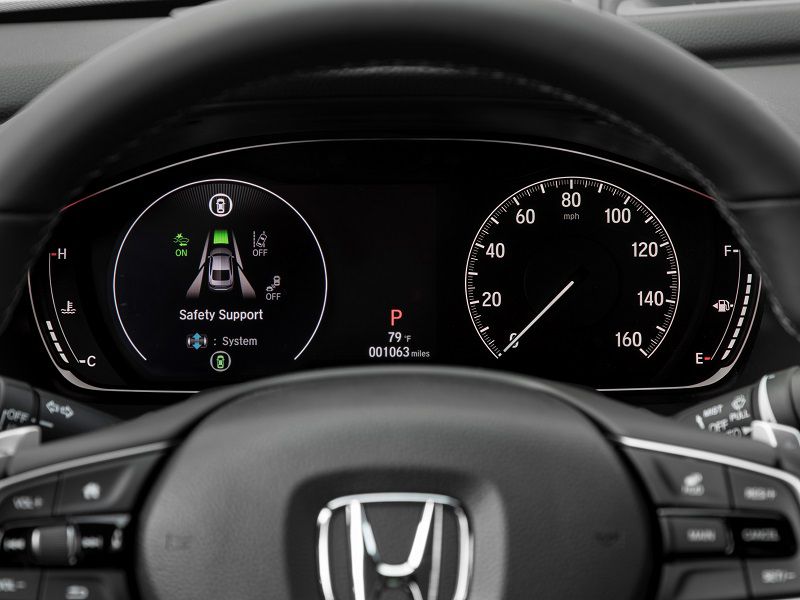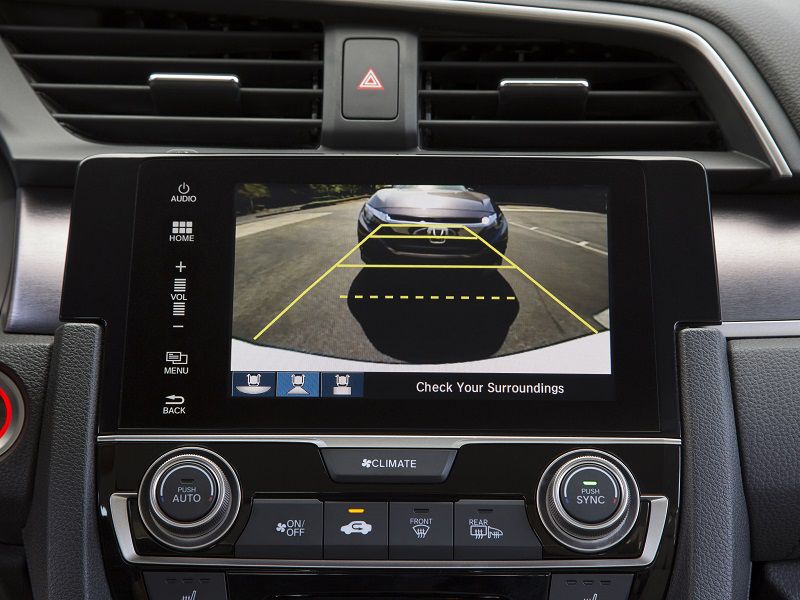Recent Articles
Popular Makes
Body Types
10 Things to Know About Honda Sensing (and LaneWatch)

2020 Honda Sensing Safety CRV ・ Photo by Honda
Like all automakers, Honda has been continuously improving its vehicles’ safety features since the first Honda car was made. Vehicle safety starts with the engineering of the vehicle’s structure and includes many different features.
However, in the past few years, technology has given us some new advanced active safety features that let the vehicle help the driver be safer. Most traffic accidents are the result of human error, and modern cars are equipped to recognize danger and alert the driver. In some cases, the car can take positive action even if the driver fails to respond. Click through to learn more about the Honda Sensing suite of advanced safety and driver assistance features.
1. Honda Sensing is the brand's suite of active safety features.
Honda Sensing is the brand name given to a set of advanced safety features put together for Honda vehicles. The name comes from the fact Hondas with the feature use cameras and radar sensors to register other vehicles, objects, and even people around the vehicle. The Honda Sensing suite includes five main features:
- Collision Mitigation Braking: This system alerts the driver to potential collisions and reduces speed to make imminent collisions less damaging if the driver fails to respond.
- Road Departure Mitigation Braking: Road departure mitigation alerts the driver when the vehicle appears likely to go off the road, and reduces speed.
- Lane Keeping Assist System: Lane-keeping alerts the driver if the vehicle begins to leave the lane, and offers steering assistance.
- Traffic Sign Recognition: Traffic sign recognition uses the vehicle’s camera to recognize road signs and displays the information.
- Adaptive Cruise Control: Adaptive cruise automatically follows the prevailing traffic speed. This is most useful in heavier “slow and go” commute traffic.

Photo by Honda
2. Collision-mitigation braking can stop the car.
Honda’s Collision Mitigation Braking system uses the vehicle’s forward-looking radar system to detect objects ahead that might cause a collision, such as stopped or oncoming vehicles, or stationary objects. The system registers an alarm for the driver and pre-charges the braking system to assist with stopping the car.
If the driver does not apply the brakes for any reason, the automatic emergency braking function takes over and attempts to stop the vehicle. Depending on the vehicle’s speed, a full stop may not be possible, but the crash damage and injuries can be reduced if the vehicle is slowing.

Photo by Honda
3. Road departure mitigation wants you on the pavement.
Honda’s radar and camera system detects lane markings and the edge of the road, and registers an alarm if the vehicle drifts too close to the edge of the lane. The system may also sound an alarm if the driver is too close to barriers like guardrails.
If the driver fails to respond to the alarm, the Road Departure Mitigation system applies gentle steering inputs to move the vehicle back into its lane. The system may also activate the brakes to mitigate damage if a lane or road departure is unavoidable. Note that the system stops operating if the driver has engaged the turn signals, because it expects the driver to change lanes or turn. Also note that this system is not self-driving and the driver must always keep both hands on the steering wheel.

Photo by Honda
4. Lane-keeping assist warns you if you drift over the line.
The Honda Lane Keeping Assist system works on the same principles as the Road Departure Mitigation system. The Honda system uses cameras to detect lane markings and to sense the vehicle’s position in the lane. If the vehicle begins to drift towards the edge of the lane, the Honda system registers an audio and visual alarm.
If the driver fails to respond to the alarm, the Honda lane-keeping system offers gentle steering inputs to ease the vehicle back to the center of its lane. The driver can easily override the steering inputs if necessary. For example, if the driver had to move over to avoid a road hazard, the system may activate. The system does not activate if the driver is using the turn signals, because the system expects a turn.

Photo by Honda
5. The system can read traffic signs.
Honda’s forward-looking camera can recognize and read speed limit signs. As the vehicle passes a speed sign, the new speed limit is displayed in the driver information center on the dashboard. If no speed limit has been detected, the system does not display any sign.
If the Honda has a head-up display, the system can also display the prevailing speed limit on the windshield. Note that these systems are not perfect, and sometimes miss signs. It is still the driver’s responsibility to see and obey all speed limits.

Photo by Honda
6. Adaptive cruise control helps you follow another car.
The most convenient feature in the Honda Sensing suite is Adaptive Cruise Control. This feature uses the vehicle’s radar to detect the vehicle directly ahead and adjusts cruise control speeds to match the leading vehicle’s speed. Note that this feature only works up to the original set speed. For example, if you set your cruise to 55 mph to match the speed limit, the system may go slower to maintain following distance to the next vehicle, but it will never exceed 55 mph.
Honda’s Adaptive Cruise Control includes the ability to set your preferred following distance as you drive. The Honda system also includes low-speed following, which allows you to activate the system while at a stop. The basic speed will be set to 25 mph, but will stop and go with traffic. This is useful in heavy commuter traffic.

Photo by Honda
7. Honda LaneWatch is a blind-spot camera.
One feature that is not part of Honda Sensing, but which is available only on Honda products, is LaneWatch. This feature eliminates the blind spot on the right-hand side of the vehicle using a rear-facing camera mounted on the passenger side mirror.
When the right-turn signal is activated, the camera displays a view of the right-side blind spot on the vehicle’s infotainment display. Instead of checking the blind spot, the driver can glance at the display to see if it’s safe to turn or change lanes to the right. Honda states that the LaneWatch system displays about four times more area than looking in the blind spot can cover. The system works only for right-hand turns, however, and isn't available on all Hondas.

Photo by Honda
8. Hondas also offer blind-spot and cross-traffic monitors.
Also not part of the Honda Sensing suite, but closely related to the technology, is blind-spot monitoring with a rear cross-traffic alert. This system uses radar mounted on the rear corners of the Honda vehicle. If there is another vehicle in the adjacent lane either overtaking or riding in the blind spot, the Honda will show a warning in or near the side-view mirror. If the Honda’s turn signal is activated, the system also plays an audible warning.
Cross-traffic monitoring uses the same radar to detect traffic approaching from either side as the Honda backs up. This is most useful in parking lots, when neighboring vehicles may obscure your lines of sight. The system also displays a wide-angle image from the multi-angle backup camera when an approaching vehicle is detected.

Photo by Honda
9. The backup camera offers multiple angles.
Honda includes a rearview camera system with multiple view choices on many of its models, letting you switch among a normal rear view, a wide-angle rear view, and a downward-looking view that shows anything that may be directly under the back of your vehicle. This view is very useful if your Honda includes towing capabilities and you need to back up to a trailer.
The rear view also includes dynamic guidelines that respond to your steering wheel inputs to predict where the rear end of your vehicle will go with the current steering angle. The multi-angle rearview camera is a useful feature for avoiding light damage, such as backing into a light pole.

Photo by Honda
10. Honda Sensing helps avoid or mitigate accidents.
The Honda Sensing suite of safety and driver assistance features, plus Honda’s unique LaneWatch and optional safety features help reduce accidents, and they reduce damage and injuries when collisions do occur.
For 2020, Honda Sensing is standard or available on most Honda models. Honda Sensing is standard equipment on all Passport, CR-V, and Pilot SUVs. The system is also included on every Civic, Accord, Insight, and Clarity. Honda Sensing is included on higher trim levels of the HR-V, Odyssey, Fit, and Ridgeline.

Photo by Honda